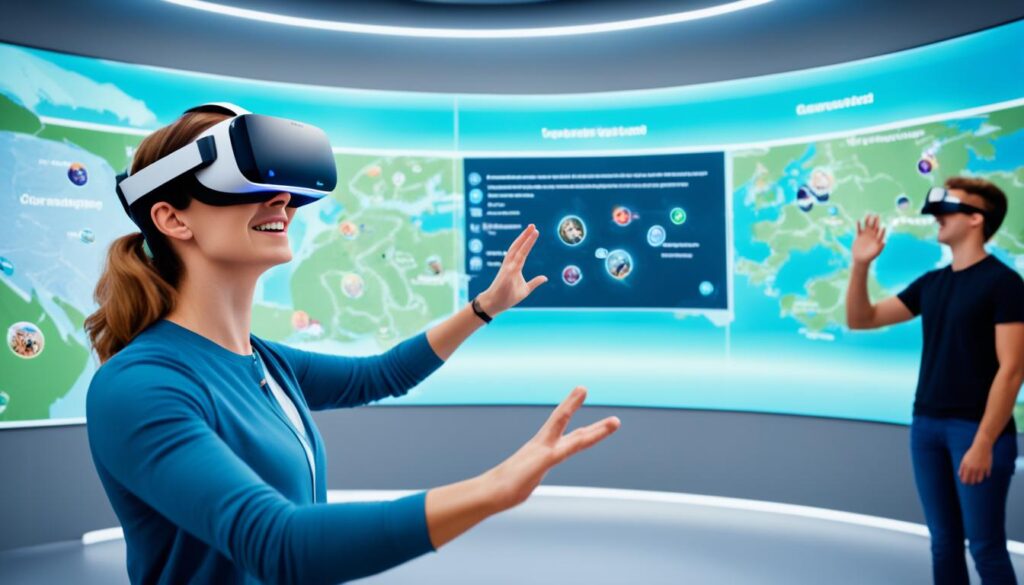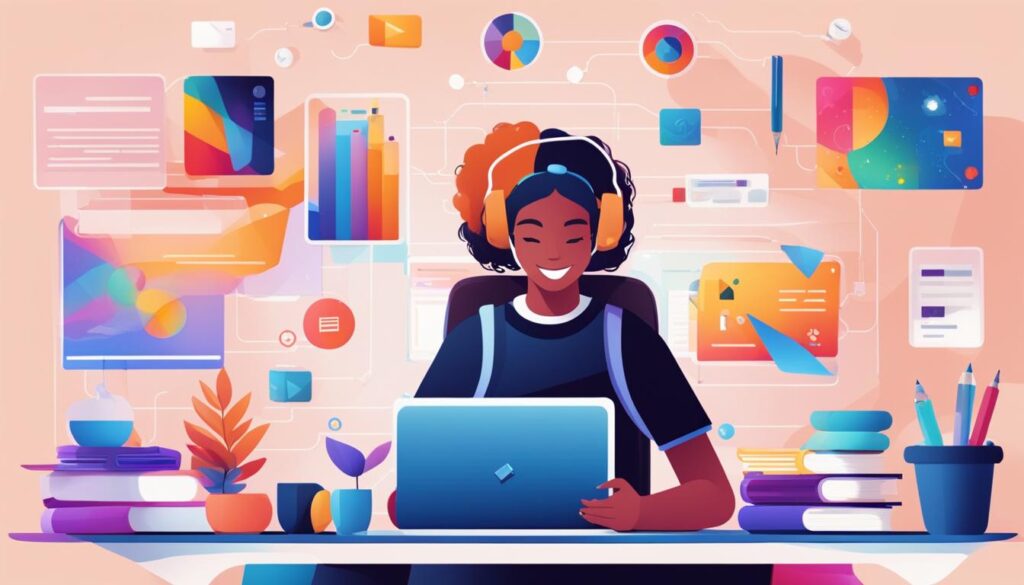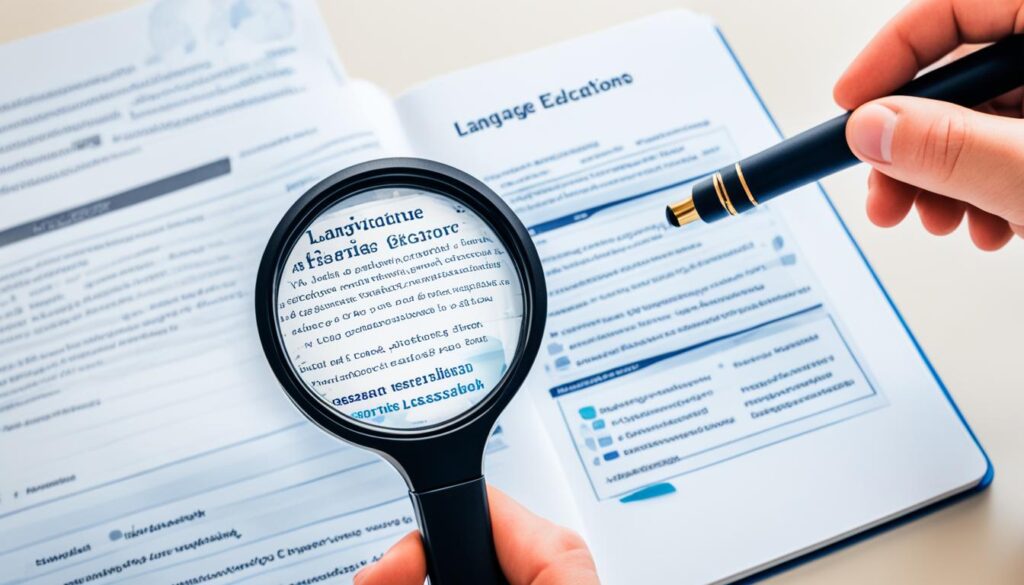The education landscape is currently witnessing a profound transformation driven by the digital revolution. In the realm of language education, this revolution has brought about a remarkable shift in the way languages are taught and learned. The integration of digital tools and the emergence of new trends have paved the way for innovative approaches that foster inclusive, engaging, and effective language education experiences.
Key Takeaways:
- The digital revolution has significantly transformed language education.
- Integration of digital tools and new trends have reshaped language teaching and learning.
- Technology plays a crucial role in creating inclusive and engaging language education experiences.
- Virtual learning environments and global connections are driving the revolution in language education.
- Language education programs are leveraging technology to enhance student engagement and language acquisition.
Embracing Flexibility in Language Education: Classrooms Anywhere, Anytime
In this section, we will delve into the concept of flexible language education, where classrooms are not confined to physical spaces but can be accessed anywhere, anytime. We will discuss the benefits of virtual learning environments, such as increased accessibility, personalized learning experiences, and the ability to collaborate with students from around the world. Additionally, we will explore how language education can build global connections and foster intercultural communication.
Benefits of Virtual Learning Environments
The integration of virtual learning environments in language education has revolutionized the way we teach and learn languages. By embracing the power of technology, educators can provide students with a flexible and dynamic learning experience. Here are some key benefits of virtual learning environments:
- Increased Accessibility: Virtual learning environments break down geographical barriers, making language education accessible to learners regardless of their location. Students can participate in classes, access learning materials, and engage in interactive exercises from the comfort of their own homes or while traveling.
- Personalized Learning Experiences: Virtual learning platforms allow educators to tailor language instruction to the individual needs and preferences of each student. With adaptive learning technologies and personalized feedback, students can progress at their own pace and focus on areas that require more attention.
- Collaboration and Global Connections: Virtual learning environments enable language learners to interact and collaborate with students from diverse cultural backgrounds. Through online discussions, group projects, and language exchange programs, students can broaden their perspectives, develop intercultural competence, and build global connections.
- 24/7 Access to Resources: Virtual learning environments provide learners with round-the-clock access to a wide range of language learning resources. From interactive multimedia materials to online libraries and language learning apps, students can immerse themselves in language learning whenever and wherever they choose.
Building Global Connects through Language Education
Language education plays a vital role in fostering global connections and promoting intercultural understanding. By embracing the flexibility offered by digital tools and virtual learning environments, language educators can create opportunities for students to connect with peers from around the world. Here are some ways language education can build these global connects:
- Virtual Exchanges: Language learners can engage in virtual exchanges with students from different countries, enabling them to practice their language skills and learn about different cultures.
- Intercultural Collaboration: Through online projects and collaborative activities, students can work together with peers from diverse cultural backgrounds, cultivating teamwork and intercultural communication skills.
- Language Learning Communities: Virtual language learning communities provide a platform for students to connect, share resources, and engage in language practice with fellow learners from around the world.
Incorporating global connects in language education not only enhances language skills but also nurtures empathy, cultural sensitivity, and a broader worldview. It prepares students to thrive in an increasingly interconnected and multicultural society.
Now, let’s have a visually engaging and relevant image to summarize the benefits of flexible language education and virtual learning:
As we can see from the image above, flexible language education and virtual learning provide learners with the freedom to access language classes and resources anytime, anywhere. With the power of technology, language education becomes more inclusive, personalized, and globally connected.
The Interactive Classroom: Revolutionizing Language Learning Engagement
The interactive classroom is revolutionizing language learning by incorporating engaging and interactive teaching methods. In this section, we will explore various strategies and techniques used to enhance student engagement, promote active learning, and improve language acquisition.
One of the key contributors to interactive language learning is technology. Through the use of digital tools, instructors can create interactive learning environments that captivate students’ attention and foster language development. Whether it’s through online platforms, language learning apps, or multimedia resources, technology provides a wealth of opportunities for students to engage with language in a dynamic and immersive way.
Gamification is another effective technique employed in the interactive classroom. By incorporating game-like elements into language lessons, educators can create a fun and challenging learning environment. Students are motivated to actively participate, compete, and collaborate, leading to increased engagement and accelerated language acquisition.
“The integration of gamification into language education has proven to be highly effective in driving student engagement and enhancing language learning outcomes,” says Professor Maria Hernandez, a renowned expert in language acquisition.
In addition to technology and gamification, incorporating immersive experiences is a powerful tool in language education. Virtual reality (VR) allows students to explore real-world scenarios and engage in authentic language use, aiding in the development of fluency and cultural understanding. By placing students in virtual environments where they can practice their language skills in context, educators can provide a truly interactive and engaging learning experience.
| Interactive Learning Strategies | Benefits |
|---|---|
| Incorporation of technology | Enhanced student engagement and language development |
| Gamification | Increased motivation, active participation, and accelerated language acquisition |
| Immersive experiences with virtual reality | Authentic language use, fluency development, and cultural understanding |
As language education continues to evolve, it is essential to embrace interactive teaching methods to maximize student engagement, retention, and language proficiency. By leveraging the power of technology, gamification, and immersive experiences, educators can revolutionize language learning and empower students to become confident language users.

Personalizing the Language Education Journey
Personalization is a key aspect of modern language education. In order to meet the unique needs and preferences of individual learners, adaptive learning technologies play a crucial role in tailoring language instruction. By utilizing these technologies, educators can create customized language curriculums that cater to different learning styles and paces, ensuring an optimal learning experience for each student.
Adaptive learning technologies employ advanced algorithms and artificial intelligence to dynamically adjust the learning content and pace based on the learner’s progress and performance. This enables personalized language education that targets specific areas of improvement and provides tailored feedback. Learners can engage in interactive activities, receive real-time assessments, and access personalized resources that enhance their language acquisition journey.
By harnessing digital tools, educators have the ability to design and curate customized language curriculums. These curriculums can be tailored to address the specific needs and goals of each learner. Digital tools offer a wide range of resources, such as interactive language exercises, multimedia content, and language learning apps, that can be incorporated into the curriculum to enhance engagement and facilitate the learning process.
Through personalized language education, learners can maximize their outcomes and engagement. By leveraging adaptive learning technologies and customizing language curriculums with digital tools, educators can create a learning environment that is attuned to the unique requirements of each learner, fostering their language proficiency and promoting a lifelong love for language learning.
Enhancing Teaching Methodologies with Digital Resources
Technology has revolutionized teaching methodologies in language education. As educators, it is crucial to embrace digital resources to enhance language instruction and create engaging learning experiences for our students. In this section, we will explore the transition from traditional teaching methods to becoming tech-savvy educators and the role of virtual reality in language teaching.
From Traditional to Tech-Savvy Educators
In today’s digital age, educators are adapting and evolving their teaching methodologies to incorporate digital resources in language education. Embracing these new tools allows us to leverage technology to deliver dynamic and interactive lessons, catering to the diverse needs and learning styles of our students.
By utilizing online platforms, language learning apps, and multimedia tools, we can provide learners with a wide range of digital resources. These resources supplement traditional classroom instruction and empower students to practice language skills outside of the classroom, fostering independent learning and self-motivation.
Moreover, digital resources enable us to personalize instruction, providing learners with tailored content and activities that cater to their unique learning preferences and goals. With the ability to track progress and provide instant feedback, digital tools facilitate continuous assessment and allow us to monitor student performance effectively.
The Role of Virtual Reality in Language Teaching
One of the most exciting digital resources in language education is virtual reality (VR). Virtual reality creates immersive language learning experiences, enabling students to engage with language in a simulated environment, and enhancing their cultural understanding.
Through VR, students can virtually travel to different countries, practice language skills in real-life scenarios, and explore culturally rich environments. This interactive and experiential learning approach not only strengthens language proficiency but also fosters cross-cultural awareness and empathy.
An immersive VR language instruction offers students the opportunity to break down geographical and cultural barriers, bringing language learning to life in a way that traditional methods cannot. By harnessing the power of virtual reality, educators can create transformative learning experiences that captivate students’ attention and deepen their language comprehension.

Overcoming Barriers: Ensuring Equitable Access in Language Learning
Access to quality language education is crucial in today’s globalized world. However, there are various barriers that can hinder learners’ opportunities to acquire language skills effectively. In this section, we will explore the importance of ensuring equitable access in language learning and discuss innovative approaches to overcome these barriers.
One of the significant challenges in language education is the digital divide. Many learners, especially those from underserved communities, may not have access to the necessary technology and internet connectivity required for online language learning. Bridging this divide is crucial to provide equal opportunities for all learners. By developing initiatives that provide access to digital resources and infrastructure, we can ensure that language education is accessible to learners regardless of their socioeconomic backgrounds.
Another important aspect of equitable language education is addressing language learning inequalities. Learners from diverse linguistic backgrounds or marginalized communities may face additional obstacles in language acquisition. It is essential to develop inclusive and culturally responsive teaching materials and methodologies that cater to the specific needs and backgrounds of these learners. By providing resources and support tailored to their unique circumstances, we can foster a more inclusive language learning environment.
Promoting inclusivity in language education programs is also crucial for ensuring equitable access. This can involve creating a safe and supportive learning environment where learners feel valued and included regardless of their abilities or backgrounds. Additionally, it may require adapting teaching strategies and materials to accommodate learners with different learning styles or disabilities. By removing barriers and embracing diversity, we can create an inclusive language education experience for all learners.
Overcoming barriers to language education requires a multi-faceted approach that addresses issues of access, inequality, and inclusivity. By adopting innovative strategies and leveraging technology, we can ensure that every learner has an equal opportunity to acquire language skills and partake in the benefits of language education.
What the Horizon Holds: Emerging Trends in Language Education
The future of language education holds promising advancements driven by emerging trends. In this section, we will explore two significant trends that are shaping the field: artificial intelligence (AI) and virtual reality (VR). These technologies are revolutionizing the way languages are taught and learned, bringing about personalized instruction, adaptive feedback, intelligence language assessment, immersive language learning experiences, and cultural immersion.
Artificial Intelligence and the Future of Language Learning
Artificial intelligence (AI) is transforming the landscape of language learning by providing tailored guidance and support to individual learners. AI-powered language learning platforms can analyze learners’ strengths and weaknesses, adapting the curriculum and content to their specific needs. With AI, students can receive personalized instruction, targeted practice exercises, and instant feedback, allowing for more efficient and effective language acquisition. Additionally, intelligent language assessment systems can evaluate learners’ performance and provide insights for improvement.
To illustrate the impact of AI in language learning, consider the example of an AI-powered chatbot designed to facilitate conversational practice. This virtual language partner can engage in natural language conversations, correct grammar mistakes, provide pronunciation guidance, and offer vocabulary suggestions. Through AI algorithms, the chatbot continuously learns from interactions with learners, adapting its responses to meet the individual’s proficiency level and learning goals.
Virtual Reality and Immersive Experiences
Virtual reality (VR) is another emerging trend that is revolutionizing language instruction by providing immersive learning experiences. VR technology allows learners to be transported to virtual environments where they can interact with realistic scenarios and practice language skills in context. This experiential approach enhances language acquisition by engaging multiple senses and creating a sense of presence and immersion.
Imagine a language student exploring a virtual city where they can order food at a restaurant, ask for directions, and communicate with virtual characters in real-time. Through VR, learners can gain practical language skills and cultural understanding by experiencing authentic situations without leaving the classroom. Additionally, VR enables educators to create customizable and interactive learning environments, where students can engage in role-playing exercises, simulations, and virtual language exchanges with peers from around the world.
As AI and VR continue to advance in language education, the possibilities for personalized, immersive, and effective language learning experiences are expanding. The integration of these emerging technologies holds great potential for transforming the way languages are taught and learned, making language education more engaging, accessible, and impactful.
Tangible Success in Language Proficiency Through Digital Means
Digital means have revolutionized language education, enabling learners to achieve tangible success in language proficiency like never before. Through the integration of digital tools and online platforms, language learners have access to innovative resources and immersive experiences that significantly enhance their language learning outcomes.
Case Studies: Breakthroughs in Digital Language Education
Let’s take a closer look at some inspiring case studies that exemplify the breakthroughs in digital language education. These real-life examples demonstrate the transformative impact of digital tools on language learning outcomes and highlight the potential for achieving remarkable success in language proficiency.
“One case study that stands out is the success story of John, a language learner who struggled to progress in his language studies through traditional methods. However, after enrolling in an online language course that featured interactive exercises, multimedia resources, and personalized feedback, John experienced significant improvement in his language skills. The digital tools provided him with targeted practice opportunities and individualized support, resulting in a breakthrough in his language proficiency.”
By analyzing such case studies, we can uncover the immense potential of digital language education to accelerate language proficiency and empower learners to achieve their language learning goals.
The Influence of Online Platforms on Language Fluency
Online platforms play a pivotal role in promoting language fluency and providing learners with valuable opportunities for language practice and immersion. These platforms offer a wide range of features that facilitate language learning, including:
- Interactive language courses led by experienced instructors
- Virtual language exchange programs for practicing conversation with native speakers
- Language learning communities and forums for peer support and collaboration
- Virtual language immersion programs that simulate authentic cultural experiences

Through the integration of these online platforms into language education, learners can immerse themselves in the language, interact with native speakers, and engage in authentic communication. This immersive and interactive approach greatly enhances language fluency and fosters a deeper understanding of the target language and culture.
Now that we have explored the transformative impact of digital language education through case studies and the influence of online platforms on language fluency, let’s move on to evaluating the effectiveness of educational tools in Section 9.
Evaluating Educational Tools: The Dual Approach to Language Acquisition
With the plethora of educational tools available, it is essential to evaluate their effectiveness and impact on language acquisition. In this section, we will explore the dual approach to language acquisition, which involves integrating traditional techniques with modern technology. By combining the best of both worlds, we can provide learners with comprehensive and engaging language learning experiences.
Integrating Traditional Techniques with Modern Technology
When it comes to language acquisition, traditional techniques such as grammar drills, vocabulary exercises, and conversation practice have long been proven effective. However, with the advancements in technology, we now have access to a wide range of digital tools that can enhance and supplement these traditional methods. By incorporating interactive language learning apps, online language courses, and multimedia resources, educators can create dynamic and immersive language learning environments.

The use of technology in language education provides learners with the opportunity to engage with language materials in interactive and engaging ways. For example, language learning apps often include features such as interactive exercises, gamified quizzes, and personalized feedback, which can motivate learners and enhance their language acquisition process. By integrating traditional techniques with modern technology, educators can cater to different learning styles and preferences, creating a more personalized and effective language learning experience.
Balancing Instructional Depth and Interactivity
When evaluating educational tools, it is crucial to strike a balance between instructional depth and interactivity. While interactive tools can enhance engagement and motivate learners, they should not compromise the depth and quality of instruction. The goal is to provide learners with meaningful and comprehensive language learning experiences that go beyond surface-level engagement.
“The key is to leverage technology as a means to enrich language instruction, rather than replacing or diminishing the importance of traditional teaching methods.” – Language Education Expert
To achieve this balance, educators must carefully evaluate the instructional depth of educational tools. This includes considering factors such as the accuracy and reliability of content, the alignment with learning objectives, and the effectiveness of feedback mechanisms. By selecting tools that offer a combination of instructional depth and interactive features, educators can create engaging language learning experiences without sacrificing the quality of instruction.
Practical Tips for Evaluating Educational Tools
When evaluating educational tools for language acquisition, educators can follow these practical tips to ensure they choose the most suitable options for their language education programs:
- Clearly define learning objectives and determine how the tools align with them.
- Consider the suitability of the tools for different learning styles and preferences.
- Assess the comprehensiveness and accuracy of the content provided by the tools.
- Explore the interactive features and engagement mechanisms offered by the tools.
- Seek feedback from other educators or language experts who have used the tools.
By following these tips, educators can make informed decisions when selecting and implementing educational tools, ultimately enhancing language acquisition outcomes for their learners.
Conclusion
In conclusion, the digital revolution in language education has revolutionized the way we teach and learn languages. Throughout this article, we have explored the various tools and trends that are driving this revolution. From virtual learning environments to interactive classrooms, personalized language education journeys, and the use of digital resources, these advancements have transformed language education.
By embracing the digital revolution, we are able to create engaging and inclusive language education experiences for learners worldwide. These advancements have opened up new opportunities for learners to access quality education anytime and anywhere. Through virtual learning environments, students can collaborate with peers from different parts of the world, fostering global connections and intercultural communication.
Moreover, the integration of technology and digital tools in language education has personalized the learning experience. Adaptive learning technologies and customized language curriculums ensure that learners receive tailored instruction based on their individual needs and preferences. This approach maximizes learner outcomes and engagement, leading to tangible success in language proficiency.
As we look into the future of language education, emerging trends such as artificial intelligence and virtual reality hold immense potential. AI can provide personalized instruction and intelligent language assessment, while VR can create immersive language learning experiences. By leveraging these advancements and maintaining a balance between instructional depth and interactivity, we can continue to enhance language education and meet the evolving needs of learners.
FAQ
What is the digital revolution in language education?
The digital revolution in language education refers to the integration of digital tools and the emergence of new trends that are reshaping the way languages are taught and learned. It encompasses the use of technology, virtual learning environments, and global connections in language education programs.
How does flexible language education work?
Flexible language education allows classrooms to be accessed anywhere, anytime, breaking the confines of physical spaces. It enables learners to engage in virtual learning environments, offering increased accessibility, personalized learning experiences, and opportunities to collaborate with students from around the world.
What are the benefits of virtual learning environments in language education?
Virtual learning environments provide increased accessibility to language education, personalized learning experiences tailored to individual learners, and the ability to connect and collaborate with students from different cultural backgrounds, fostering global connections and intercultural communication.
How does the interactive classroom revolutionize language learning engagement?
The interactive classroom incorporates engaging and interactive teaching methods to enhance student engagement, promote active learning, and improve language acquisition. It utilizes technology, gamification, multimedia resources, and immersive experiences to create interactive learning environments that make language learning engaging and effective.
How can language education be personalized?
Language education can be personalized through the use of adaptive learning technologies, which tailor language instruction to individual learners’ needs and preferences. Digital tools can also be used to customize language curriculums, catering to different learning styles and pacing, to create a personalized language education journey that maximizes learner outcomes and engagement.
How can educators enhance their teaching methodologies with digital resources?
Educators can enhance their teaching methodologies by embracing digital resources such as online platforms, language learning apps, and multimedia tools. These resources provide additional support, interactive materials, and innovative teaching strategies to create engaging language instruction. Additionally, virtual reality can be incorporated into language teaching to create immersive learning experiences and enhance cultural understanding.
How can barriers to language learning be overcome?
Barriers to language learning can be overcome through innovative approaches that ensure equitable access to language education. This includes bridging the digital divide, addressing language learning inequalities, and promoting inclusivity in language education programs.
What are the emerging trends in language education?
Two significant emerging trends in language education are artificial intelligence (AI) and virtual reality (VR). AI is revolutionizing language learning through personalized instruction, adaptive feedback, and intelligent language assessment. VR provides immersive language learning experiences and cultural immersion, enhancing the way languages are taught and learned.
How does digital means contribute to tangible success in language proficiency?
Digital means, such as online platforms, language exchange platforms, and virtual language immersion programs, have been instrumental in achieving tangible success in language proficiency. These resources offer enhanced language learning opportunities, interactive materials, and cultural immersion experiences, all of which contribute to improving language fluency.
How can educators evaluate educational tools for language acquisition?
Educators can evaluate educational tools by adopting a dual approach that integrates traditional techniques with modern technology. It is important to maintain a balance between instructional depth and interactivity when selecting educational tools to ensure effective language learning experiences. Educators should consider the suitability, effectiveness, and alignment with their language education programs.
Source Links
- https://www.linkedin.com/pulse/embracing-change-digital-revolution-education-somnath-mukherjee-nhxoc?trk=articles_directory
- https://blog.thepienews.com/2023/06/the-global-classroom-tefl-and-the-digital-revolution/
- https://medium.com/@leucopsis/the-digital-shift-in-language-learning-exploring-the-potential-of-chatgpt-31a5835ef56d

